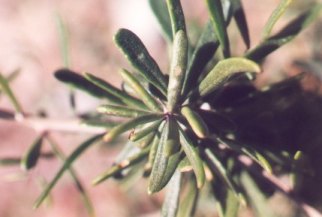|
 WOLFBERRY - Lycium sp. Bocksdorn, Box Thorn, Desert Thorn, Frutilla, Lyciet, Lycium, Matrimony Vine,
Teufelszwirn, Thorn Bush, Tomatillo. Russian: Dereza. Zuni: Kiapuli "waterfall down". All Sonoran desert species
have edible fruit, gathered in the spring. They are edible raw or cooked in soup, stew, syrup, sauce, or
beverages. Boil the berries to a thick consistency and dry them on rocks in the sun. They can be stored and eaten
as is, or cooked. Dried berries can be made into mush or soup without cooking. Boil and mash the berries and drain
the liquid as a beverage. Or grind them and mix with a little clay before eating. Not quite ripe berries were
boiled and sweetened. The Comcaac used the green wood to make a tuning peg for the violin. Sometimes Lichens like
to inhabit Lycium. This is particularly true in the Boojum habitat. Some Lichens that like to do so are Physcia
aipolia, Xanthoria polycarpa, and X. elegans.
WOLFBERRY - Lycium sp. Bocksdorn, Box Thorn, Desert Thorn, Frutilla, Lyciet, Lycium, Matrimony Vine,
Teufelszwirn, Thorn Bush, Tomatillo. Russian: Dereza. Zuni: Kiapuli "waterfall down". All Sonoran desert species
have edible fruit, gathered in the spring. They are edible raw or cooked in soup, stew, syrup, sauce, or
beverages. Boil the berries to a thick consistency and dry them on rocks in the sun. They can be stored and eaten
as is, or cooked. Dried berries can be made into mush or soup without cooking. Boil and mash the berries and drain
the liquid as a beverage. Or grind them and mix with a little clay before eating. Not quite ripe berries were
boiled and sweetened. The Comcaac used the green wood to make a tuning peg for the violin. Sometimes Lichens like
to inhabit Lycium. This is particularly true in the Boojum habitat. Some Lichens that like to do so are Physcia
aipolia, Xanthoria polycarpa, and X. elegans.
L. andersonii (L. andersoni, torreyi): Anderson Lycium, Boxthorn, Anderson Thorn
Bush, Squaw Thorn, Water Jacket. Kawaiisu: Huupivi. Paiute: Hoopiv. Seri: Hahoj enej "empty lycium", Hahoj inail
coopol "black barked lycium". The juicy berries can be eaten fresh, boiled, or dried and stored. They can be
squeezed; the juice is drunk. They are boiled and mashed and the liquid used as a beverage, or made into mush.
Also, cook a cup of fresh berries with half a cup of sugar and half a cup of water, then thicken with flour. They
can be made into meal which is made into a paste for eating. The plant is also host to the root rot fungus,
Phymatotrichum omnivorum.

L. berlanderi (L. berlandieri, parviflorum, peninsulare, brachyanthum, Citharexylum
brachyanthum): Barchata, Berlander's Lycium, Desert Thorn, Garambullo. Warihio: Hoso. The fruit is
edible. It tends to dry out the mouth, but can be eaten raw in quantities of a handful or so. They have a tart to
mildly bitter flavor. Eat them when they are fully orange in color. The berries contain 17% protein, and are high
in potassium. Variation in spelling: Burlander.
L. brevipes (L. richii, richie, palmeri, cedrosense). Seri: Hahoj an quinelca
"empty lycium". The ripe berries are edible raw or cooked. The green berries were strung on necklaces.
L. californicum: Tomatillo. Seri: Hahoj izii "small lycium". The fruit is bitter and not edible.
L. chinensis: Kao Chi Tza, Lych Berry, exotic. The berry tea is tonic and used for the liver, kidneys, and
pancreas. It is good for diabetes.
L. fremontii (L. gracilipes, retusum, exsertum): Boxthorn, Desert Thorn, Fremont
Thornbush, Squawberry, Squawbush, Tomatillo. Hahoj cacat "tart lycium". The juicy berries are edible mashed, mixed
with wheat or Barrel Cactus flowers, and with honey or sugar if needed, and boiled. Eating too much could cause
temporary limb paralysis. The berries were gathered from pack rats' nests, packed in slabs, which were broken up,
boiled, and eaten. As long as the Hanta virus is in an area, DO NOT EAT ANY FOOD FROM PACK RATS' NESTS. The violin
bow was made from the wood, which was also used to make arrows.

L. halimifolium (L. chinense): Box Thorn, Matrimony Vine. Naturalized. This
plant is toxic, possibly containing a solanaceous alkaloid. Livestock and humans eating young shoots as a potherb
have been poisoned. It is said, however, that the berries are edible by humans and birds.
L. macrodon. Seri: Hehe iix coil "blue green sapped plant". The fruit is inedible, but is used while green to
make necklaces.
L. pallidum. Desert Thorn, Desert Wolfberry, Matrimony Vine, Rabbit Thorn, Tomatilla, Tomatillo. Diné:
Haashcheedaa, Xaactceetaa "God's food". Do not confuse this plant with the Tomatillo that grows inside a leaflike
sheath, to a fairly good size, which resembles a tomato. The flowers, which bloom in late winter, are a good
source of honey. The fresh ripe, red berries are edible, up to a half cup per day. Eating too many of the berries
causes the tongue to dry out and crack, which lasts for a short time. They are also edible in a sauce, usually
cooked or ground with an equal quantity of saline white food clay to take away bitterness. They can be boiled,
dried on rocks, and stored for winter, eaten dried, or made into soup. A "lemonade" is made by boiling 1/2 cup of
berries in a quart of water. Tie the berries in a porous cloth before boiling them for 10 to 15 minutes. Add sugar
to taste. Discard the sediment on the bottom. A tea of the leaves is said to be good for pleurisy. Also use a
poultice of the leaves on the chest. The tea may be used freely, approximately 1 cup three times a day. The ground
root is used for toothache. Emetic.
L. parishii (L. pringlei): Parish Thornbush. This one has juicy berries.


|

